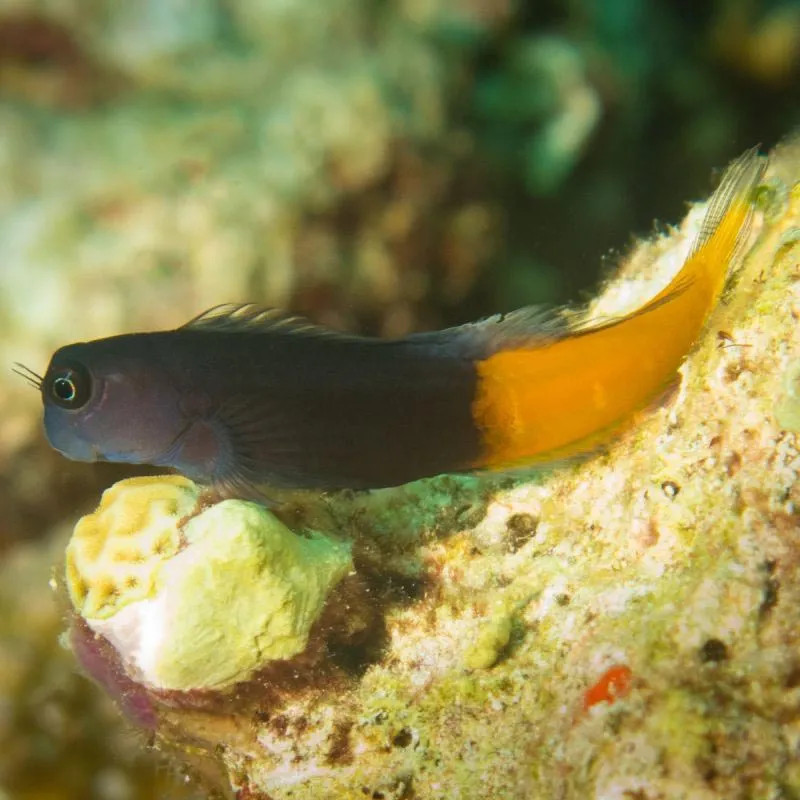Stocks Available
RED SCOOTER BLENNY
SKU:200810
SYNCHIROPUS STELLATUS
N/A

Stock Available
Introduction: • Species: Bicolor Red Tail Blenny • Common Names: Bicolor Blenny, Red Tail Blenny • Natural Habitat: Found in the warm waters of the Indo-Pacific region, primarily inhabiting coral reefs and rocky environments where it can find shelter among the crevices. Physical Characteristics: • Appearance: This species features a slender body with a striking color contrast; the front half is typically a vibrant yellow or gold, while the rear half transitions into a deep red or orange tail. • Size: Reaches an average length of about 4-5 inches (10-13 cm). • Lifespan: Can live around 4-6 years in a well-maintained aquarium. Habitat Requirements: • Tank Size: A minimum of 20 gallons is recommended to provide adequate swimming space and hiding spots. • Water Conditions: o Temperature: Thrives in temperatures between 75-82°F (24-28°C). o pH: Prefers a slightly alkaline environment with a pH of 8.1-8.4. • Aquascaping: Incorporate plenty of rocks, caves, and hiding spots to mimic its natural environment, allowing the blenny to feel secure. Diet: • Primary Diet: Herbivorous; mainly feeds on algae and other plant materials in its natural habitat. • Supplemental Feeding: Offer high-quality marine flakes or pellets, along with occasional frozen or live foods such as brine shrimp and spirulina. • Feeding Frequency: Feed small portions multiple times a day to ensure a balanced diet. Compatibility: • Temperament: Generally peaceful, but can become territorial, particularly with similar-looking species. • Suitable Tank Mates: Best housed with other peaceful fish like clownfish, gobies, and small wrasses. • Incompatibilities: Should avoid aggressive species that might harass or outcompete the blenny. Care Level: • Difficulty: Moderate; requires stable water conditions and a diverse diet for optimal health. • Health Monitoring: Regularly check for signs of stress, illness, or parasites, as blennies can be sensitive to changes in water quality. Breeding: • Breeding in Captivity: Rarely bred in aquariums, but some enthusiasts have reported success in well-established setups. • Spawning: Typically lays eggs in secluded areas, with males displaying protective behavior over the eggs. Economic Considerations: • Market Demand: Gaining popularity among marine aquarists for its unique coloration and relatively easy care. • Wholesale Pricing: Prices can vary based on size and coloration, with larger specimens typically commanding higher prices. • Retail Pricing: Generally sold at moderate prices, reflecting its desirability in the aquarium trade. Sustainability and Conservation: • Wild Population: The population is generally stable; however, habitat destruction and over-collection are concerns for future sustainability. • Aquaculture Efforts: Limited captive breeding efforts exist, emphasizing the need for sustainable practices in harvesting. • Regulations: It’s essential to comply with local and international regulations regarding the trade of marine species. Conclusion: The Bicolor Red Tail Blenny is a captivating addition to reef aquariums, admired for its striking appearance and interesting behaviors. With proper care and a suitable environment, this blenny can thrive and provide a vibrant touch to any marine setup, enriching the experience for aquarium enthusiasts.
Data sheet
16 other products in the same category:
Customers who bought this product also bought: